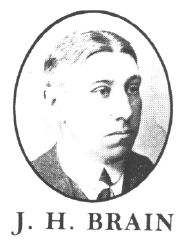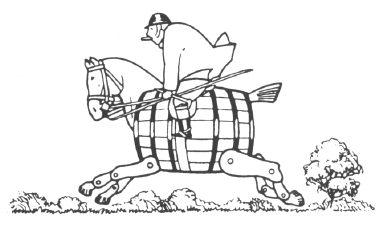
Copyright © 2003 the Brewery History Society
|
Journal Home > Archive > Issue Contents > Brew. Hist., 111, pp. 34-37 |
Sporting Brewers |
by Gron Williams |
When Thomas Rotherham Phillips moved his ale-making interests from Northampton in 1874, he took to Newport, Monmouthshire, more than just brewing expertise and business acumen. In typical Victorian abundance he was the father of ten lusty sons bursting with enthusiasm for the new, exciting game of rugby football.
In the year the Phillips family arrived, they called a meeting at the New Dock Brewery to establish a club that was to become renowned in world rugby. Eldest son William was the first club captain and several of his brothers played. In his younger days father Thomas had enjoyed more traditional sport, hunting with the Duke of Grafton's Hounds and the Pytchley.
The Phillips clan (as traced in the Journal No 49, October 1986) were a Victorian brewing phenomenon, at one time owning nine brewing companies from South Wales to Suffolk. All have now vanished. Simonds of Reading who, I believe, held a supply monopoly for Great Western Railway buffets and dining cars, bought the Newport company in 1949.
In the 20th century, Newport established a local derby rivalry with Cardiff just 13 miles down the road. Reminiscent of the "old firm" Glasgow battles between Rangers and Celtic, it led to eight matches a season in some cases and usually six, between these Welsh "enemies" in a period when there were no leagues or cup competitions to restrict fixture making.
The Cardiff club, like Newport, owed a debt to brewers from England who had set up in the port. William Hancock and his family, Somerset brewers from Wiveliscombe, moved into the Bute Dock premises in 1884 and expanded rapidly in an area booming with an export bonanza in coal and steel.
One of the younger Hancock directors, 23-year-old Frank, went into the Cardiff first team in 1884. This 5 foot 9 inch tall centre three-quarter back soon became involved in one of the great tactical innovations of the era. It had been customary to play just three men in the three-quarter line, two wings and a centre. On the arrival of Hancock, Cardiff decided to experiment with four, inserting him as an extra centre.
Cardiff, using this system and with Hancock as skipper, had an invincible record in 1885-1886 as a result of their greater flexibility in attack. Wales then reluctantly adopted the two-centre formation but it failed on a muddy day and Hancock was dropped after only his fourth cap. It took a couple more years for the new formation to be accepted, as it was eventually by all nationalities though they call it something else in the Southern Hemisphere.
The other big Cardiff brewers, the Brains, moved in during 1882 from Bristol, but they did their bit not for rugby, but for Glamorgan cricket, then languishing among the Minor Counties. The founder of the company, A S Brain, brought with him two first cousins who both eventually succeeded him as Chairmen.
Both became prominent Glamorgan batsmen. W H Brain scored the club's first century in 1897 while Oxford Blue J H Brain regularly topped the averages, frequently kept wicket and captained the side. He was a driving force on the committee, threatening to resign in 1894 because of his "great disappointment at the apathy of players and the difficulty of putting a good team in the field". That obviously had an effect because he did not resign the captaincy until 1906, going out on a high note with 24 catches and 17 stumpings in 12 Minor Counties games.
|
|
 |
|
|
Brains, the only sizeable independent now left in Wales, have always been keen to employ sporting "names" as licensees, notably Peerless Jim Driscoll, probably the world's premier featherweight in National Sporting Club days, who was mine host of the Duke of Edinburgh. Among rugby stars who kept Brains houses was Wick Powell, a massive scrum half with the Welsh Guards and London Welsh, who played in 25 internationals between 1926 and 1935. Powell was for many years licensee of the Cardiff Cottage in St Mary Street.
Towards the end of its life, another leading South Wales company was chaired by an Olympic show jumping gold medalist. Lieutenant Colonel Sir Harry Llewellyn took over in 1958 at the century old Rhymney Brewery, located on the Monmouthshire-Glamorgan border.
Before the company was swallowed up by Whitbread in 1966, one of Harry's more pleasing duties was to name a new Hereford pub after his 1952 Helsinki Olympic horse, Foxhunter. By coincidence, before Llewellyn's arrival, Rhymney adopted the advertising logo of a galloping barrel with a huntsman aboard. One of Sir Harry's sons, Roddy, was a friend of Princess Margaret during her Mustique days.
Many famous sportsmen found a niche in the brewing trade. T P Wright, tight-head prop with Blackheath, England and the touring Lions, was for many years free trade manager of Wadworth at Devizes. He won 13 England caps in the early 1960s and toured South Africa with the 1962 Lions. Wright died earlier this year.
Sporting licensees have been myriad, including cricketers Tom Graveney and Godfrey Evans, boxers Tommy Farr and Jack Hood, soccer legend John Charles and snooker's Doug Mountjoy.
|
|
 |
|
|
I can recall occasional soccer directors from the trade but the club which seems to have benefited must from the connection is Ipswich Town. Cobbold & Co of the local Cliffe 36 Brewery History Number 111 Spring 2003
Brewery had brothers on the soccer board from 1948–1991. John Cobbold was chairman from 1957 to 1976 and Pat Cobbold succeeded him 1976 to 1991. They employed such future England managers as Sir Alf Ramsay and Sir Bobby Robson, plus such other bosses as Jackie Milburn, Bill McGarry and Bobby Ferguson, who kept the Suffolk flag flying in the top divisions of the Football League for decades.
|
Smith, D & Williams, G. (1980) Fields of Praise. University of Wales. |
|
The Cardiff Brewery. (1982) S A Brain & Co. |
|
Morgan, J.H (1952) Glamorgan |
|
Rhymney Brewery (1959) Company brochure |
|
Ipswich Record Office |